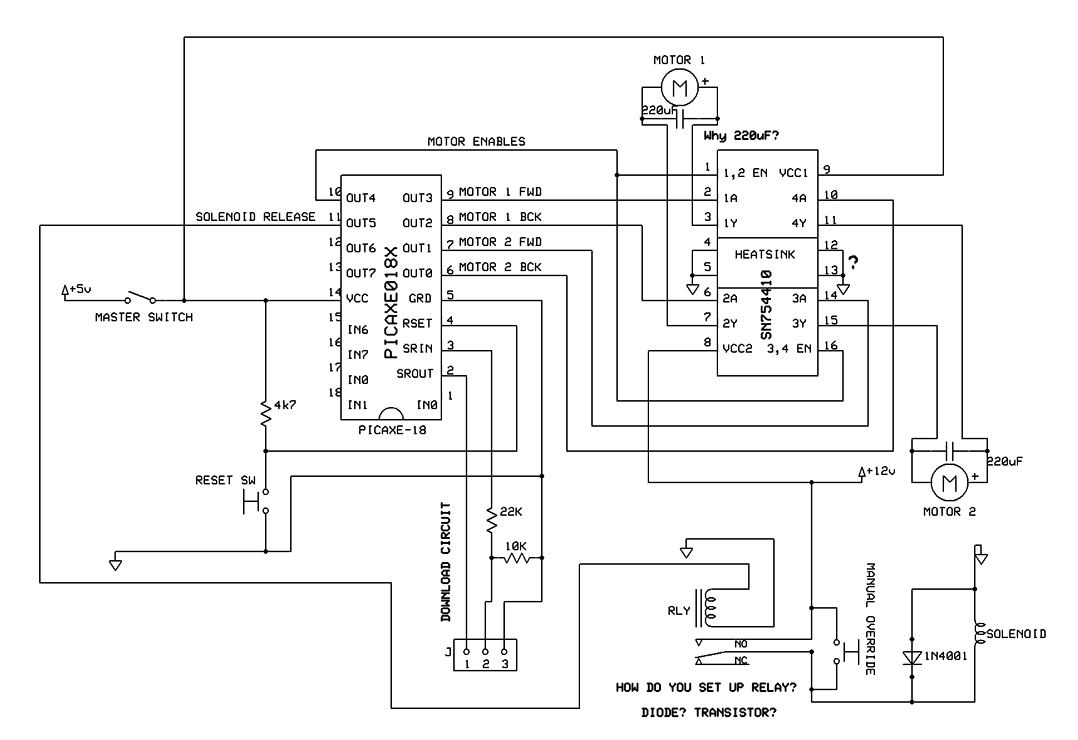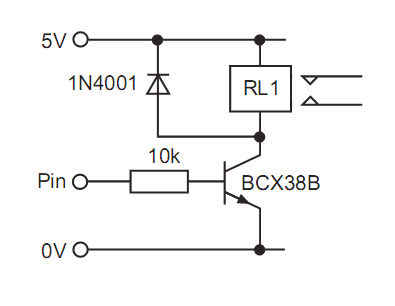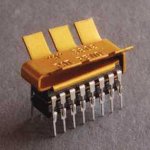I am designing a circuit to control a tank tracked robot (one motor per track), as well as a solenoid mounted on the front of the vehicle.
I've hacked together a schematic after looking at datasheets for many an hour, and because of my limited electronics knowledge (haven't taken it at uni yet) there are a few things i don't understand. I have attatched the schematic. I am using an 18 pin PICAXE chip in conjunction with a quadruple half h driver (Probably an SN754410). The motors will run off 12V supply but i haven't bought them yet so their current draw is as of yet unknown (will be less than 1A).

1) The Elusive Ground
From my high school electronics (i didn't pay much attention) i was lead to believe that the -ve terminal of a battery acts as ground in a circuit, but i'm not quite sure how it works if i'm using both a 5V source and a 12V source.
Can i run things from the hot of the 12V source into the ground of the 5V? Where do i ground the heatsink of the SN754410? I understand it's necessary for all parts to reach ground but i'm not sure exactly what constitutes as ground.
2) Relays
The solenoid will probably draw too many amps for the picaxe to output. This means i need a relay (and maybe a JFET to power this relay, we'll see). Anyway, the PICAXE interface guide has an example of a relay (attatched). It shows a lead from the 5V source, through the relay, to a JFET powered by the picaxe. How does that work? I'm not too familiar with transistors, but doesnt the arrow mean the emitter? Wouldnt current want to run from E to C, not the otherway round? A little help with how i would set up my relay would be well appreciated.

3) Back EMF Protection
I've read that the back EMF created when an induction powered device is turned off can blow your IC to pieces, so you stick a diode in parallel with it (Also seen in the relay example) . How does this work? Wouldn't the back EMF still want to go to ground, rather than to the 5V supply. Is it just because there's a load in front of ground that it'd rather route to 5V (no load other than the diode), my physics background would make me think the force would be stronger towards the 0V terminal.
4) Noise Suppression on Motors
How does a capacitor in parallel to a motor suppress electrical noise? Is the motors rotational magnetic field what causes the noise? What does the capacitance have to do with it (why does everyone use a 220uF capacitor?)
5) PCB Design / Crossing Traces
When it finally comes down to it, how do i make the PCB, since a lot of my wires overlap. I never see any wire bridges on small professional circuit boards (single layer), so how do they manage to get interweaving traces? Do they use tiny resistors to save time? what's the big secret, i'm having a hard time.
Final Note:
Sorry about the rant. If you see any problems with my schematic i'd love to know, Rip it to shreds i'm happy to redo it from scratch just to learn. Thanks in advance.
I've hacked together a schematic after looking at datasheets for many an hour, and because of my limited electronics knowledge (haven't taken it at uni yet) there are a few things i don't understand. I have attatched the schematic. I am using an 18 pin PICAXE chip in conjunction with a quadruple half h driver (Probably an SN754410). The motors will run off 12V supply but i haven't bought them yet so their current draw is as of yet unknown (will be less than 1A).

1) The Elusive Ground
From my high school electronics (i didn't pay much attention) i was lead to believe that the -ve terminal of a battery acts as ground in a circuit, but i'm not quite sure how it works if i'm using both a 5V source and a 12V source.
Can i run things from the hot of the 12V source into the ground of the 5V? Where do i ground the heatsink of the SN754410? I understand it's necessary for all parts to reach ground but i'm not sure exactly what constitutes as ground.
2) Relays
The solenoid will probably draw too many amps for the picaxe to output. This means i need a relay (and maybe a JFET to power this relay, we'll see). Anyway, the PICAXE interface guide has an example of a relay (attatched). It shows a lead from the 5V source, through the relay, to a JFET powered by the picaxe. How does that work? I'm not too familiar with transistors, but doesnt the arrow mean the emitter? Wouldnt current want to run from E to C, not the otherway round? A little help with how i would set up my relay would be well appreciated.

3) Back EMF Protection
I've read that the back EMF created when an induction powered device is turned off can blow your IC to pieces, so you stick a diode in parallel with it (Also seen in the relay example) . How does this work? Wouldn't the back EMF still want to go to ground, rather than to the 5V supply. Is it just because there's a load in front of ground that it'd rather route to 5V (no load other than the diode), my physics background would make me think the force would be stronger towards the 0V terminal.
4) Noise Suppression on Motors
How does a capacitor in parallel to a motor suppress electrical noise? Is the motors rotational magnetic field what causes the noise? What does the capacitance have to do with it (why does everyone use a 220uF capacitor?)
5) PCB Design / Crossing Traces
When it finally comes down to it, how do i make the PCB, since a lot of my wires overlap. I never see any wire bridges on small professional circuit boards (single layer), so how do they manage to get interweaving traces? Do they use tiny resistors to save time? what's the big secret, i'm having a hard time.
Final Note:
Sorry about the rant. If you see any problems with my schematic i'd love to know, Rip it to shreds i'm happy to redo it from scratch just to learn. Thanks in advance.

